In the digital era, businesses continuously seek innovative tools to increase efficiency, reduce costs, and improve customer satisfaction.
One of those transformative tools is Robotic Process Automation (RPA).
Modern Spend Management and Accounts Payable software.
Helping organizations spend smarter and more efficiently by automating purchasing and invoice processing.
We saved more than $1 million on our spend in the first year and just recently identified an opportunity to save about $10,000 every month on recurring expenses with PLANERGY.

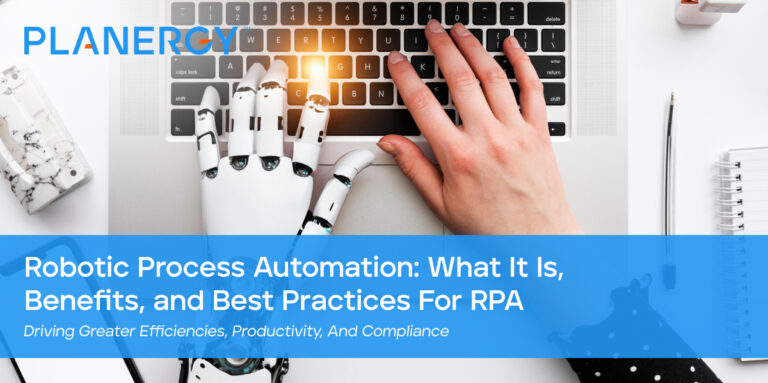
In the digital era, businesses continuously seek innovative tools to increase efficiency, reduce costs, and improve customer satisfaction.
One of those transformative tools is Robotic Process Automation (RPA).
Robotic process automation (RPA) is a software technology that allows software robots or ‘bots’ to mimic human activities by interacting with digital systems and applications.
The technology is used to automate repetitive, rule-based tasks, which are usually time-consuming and prone to errors when performed by humans.
RPA bots work by accessing data, interpreting responses, triggering actions, and communicating with other systems.
How the bots interact with the data and systems is based on predefined instructions that the bot will perform at speed and without errors.
They can log into applications, enter data, calculate and complete tasks, and then log out. This is all done without human intervention.
There are several ways you can use RPA automation technology as part of your digital transformation and business process management (BPM).
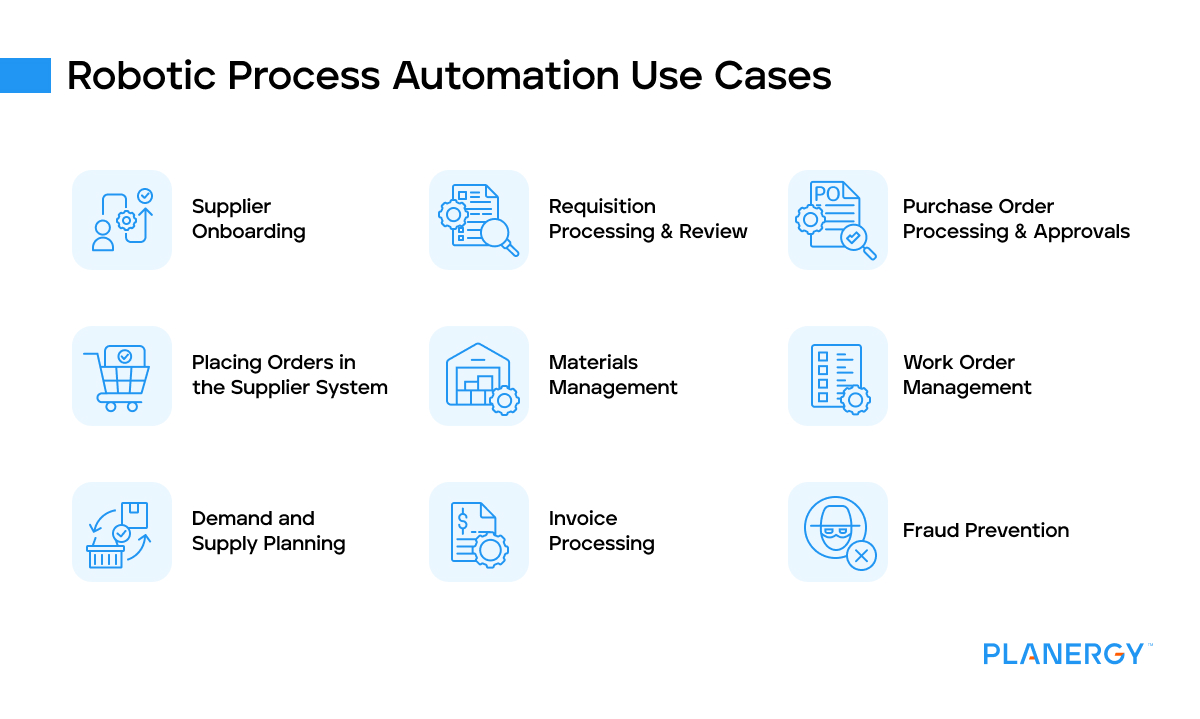
RPA can be used to automate supplier onboarding processes.
The bot can extract data from forms, validate it, and enter it into the relevant systems. This reduces the time spent on manual tasks and minimizes errors.
RPA’s capabilities can be leveraged in the procurement industry to automate the process of reviewing and processing purchase requisitions.
This reduces the time and manual effort involved in these tasks, streamlining business operations and making them more efficient.
The automation can ensure that all requisitions meet the necessary criteria before processing, increasing accuracy and reducing the chance of errors.
From purchase request to final approval, RPA can automate the entire purchase order process.
This accelerates purchase order cycle time and minimizes errors often associated with manual data entry for purchase orders.
Doing so helps organizations maintain control over their spending, ensuring that all purchases are correctly recorded and approved.
PLANERGY utilizes this technology in specific areas of it’s procure-to-pay software. For example, the purchase order approval workflow automation uses RPA to get the correct approvals at each step.
Another area where RPA proves beneficial is in placing orders within the supplier’s system.
Automating this task eliminates the need for manual intervention, freeing up employees’ time for more strategic activities.
It also ensures that orders are placed accurately and on time, smoothing out the procurement process.
Dedicated integration options, like PunchOut catalog integrations, would reduce the need for a separate solution for this.
PLANERGY supports PunchOut integrations with a large number of suppliers.
RPA can be instrumental in managing inventory levels. It can monitor stock levels automatically and notify the procurement team when inventory levels are low.
This proactive approach prevents stock-outs and ensures that the supply chain runs smoothly.
RPA can streamline the process of creating, tracking, and closing work orders.
This can improve productivity and reduce the likelihood of errors. It also ensures that work orders are handled promptly, improving customer satisfaction.
RPA can assist in demand and supply planning by analyzing historical data and forecasting future needs.
This helps organizations to balance their inventory levels more effectively, avoiding overstock and stock-out situations.
It also enables a more proactive approach to procurement, as potential issues can be identified and addressed before they become problems.
The bot can be used to automate steps in the overall invoice processing and approval workflows.
When this is combined with OCR, AI, and relevant upstream data, like in PLANERGY’s AP Automation software, you can extract data from invoices, match it with purchase orders, and process payments, freeing up staff to focus on more value-added tasks.
According to recent statistics, the anti-money laundering process is “highly manual”.
Analysts are said to spend only 10% of their time on analysis, while up to 75% goes towards collecting data, and 15% is allotted for data entry and management.
Because bringing money laundering activities to a halt is time-sensitive, RPA technology would be a great solution.
For instance, rules could be designed to reduce analysts’ time – freeing them to focus on more pertinent tasks.
Data entry can be automated using data capture and input, as is the case with AP Automation software.
Or, the rules could be set to flag a potential threat if a specified number of transactions were made within a specified period of time.
With a growing compound annual growth rate (CAGR) of 30.9% from 2021 to 2030, it is clear that the benefits of RPA or potential benefits speak for themselves.
In fact, Gartner says 80% of financial leaders have implemented or plan to implement robotics process automation.
The key benefits RPA offers can be grouped in a few headline areas.

RPA bots are designed to work tirelessly around the clock.
Unlike human workers who require breaks and time off, RPA can operate 24/7 without any interruptions.
This increases productivity significantly as tasks can be performed at any time of the day or night, including weekends and holidays.
This allows businesses to get more done quickly, boosting overall efficiency.
One of the key benefits of RPA is its ability to eliminate human error.
Even the most diligent human workers can make mistakes, especially when performing monotonous, repetitive tasks.
RPA bots, on the other hand, follow the exact instructions they are programmed with, ensuring that tasks are performed accurately every single time.
This leads to higher quality output and fewer errors, saving businesses significant time and money in rectifying mistakes.
By automating repetitive tasks, businesses can achieve significant cost savings.
Implementing RPA can reduce the need for human involvement in mundane tasks, freeing up staff to focus on more strategic, value-added activities.
Furthermore, RPA software bots can perform tasks faster than humans, allowing for more work to be done in less time.
Reduced labor and increased productivity can lead to substantial cost savings for businesses.
With faster and more accurate processes, businesses can improve their customer service levels.
For instance, RPA can be used to automate customer service responses, ensuring customers receive quick and accurate information.
This can lead to improved customer satisfaction and loyalty, which are key drivers of business success.
Gartner research says 80% of financial leaders have implemented or plan to implement robotics process automation.
RPA and AI, or Artificial Intelligence, are both technologies that automate tasks traditionally performed by humans.
However, they operate on different principles and are used for different purposes.
RPA is like a digital worker that follows pre-set rules and instructions to complete tasks.
Typically, RPA is used for data entry, invoice processing, or order management tasks. These are tasks that don’t require decision-making or problem-solving skills.
They just need to be performed the same way, over and over again.
RPA is relatively easy to implement and requires no changes to the existing IT infrastructure.
It’s also non-intrusive and can work with any software system that has a user interface, just like a human worker would.
AI, on the other hand, is a more complex technology that simulates human intelligence.
This includes learning from experience (machine learning), understanding natural language (natural language processing or NLP), recognizing patterns (pattern recognition), and making decisions.
Unlike RPA, AI can handle unstructured data and make decisions based on it.
For example, an AI system could analyze customer feedback to determine their sentiment or recommend products based on a customer’s browsing history.
AI requires more sophisticated programming and more data to function effectively. It’s also typically more expensive and time-consuming to implement than RPA.
Here are some other good examples of AI in accounts payable and AI in procurement.
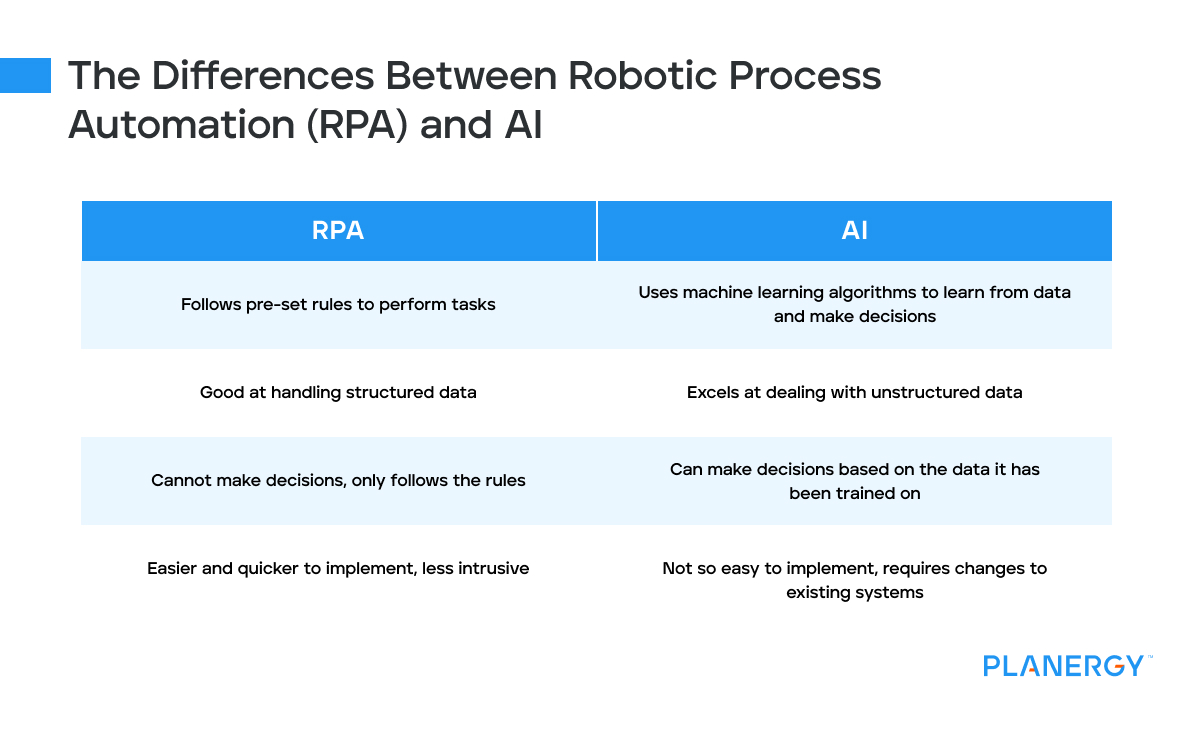
Complexity: RPA is less complex than AI. It follows pre-set rules to perform tasks, while AI uses machine learning algorithms to learn from data and make decisions.
Data Handling: RPA is good at handling structured data, while AI excels at dealing with unstructured data.
Decision-Making: RPA cannot make decisions. It can only follow the rules. AI, on the other hand, can make decisions based on the data it has been trained on.
Implementation: RPA is generally easier and quicker to implement than AI. It’s also less intrusive, as it doesn’t require changes to existing systems.
Ultimately, both RPA and AI have their place in business automation.
RPA is great for automating repetitive, rule-based tasks, while AI is ideal for tasks requiring decision-making or handling unstructured data.
Many businesses use a combination of both technologies to achieve optimal results.
While both involve automation, the difference lies in their complexity. Process automation refers to automating entire workflows involving multiple tasks and decisions.
RPA, on the other hand, is used for more simple, rule-based tasks within that process.
RPA works by mimicking human actions. It interacts with software applications like a human would – by clicking on-screen elements, typing into fields, copying and pasting data, and so on.
This allows RPA to be used with virtually any software system without requiring any changes to the existing IT infrastructure.
BPA, on the other hand, involves automating entire business processes that may include multiple tasks and decisions.
These processes are often more complex and require coordination between different departments or systems.
For example, a procurement process might involve steps like supplier selection, purchase order creation, invoice processing, and payment approval.
Automating this process would require integrating different systems and setting up workflows to manage the various tasks and decisions.
BPA often involves more than just task automation. It can also include process modeling, workflow design, integration with other systems, and even decision automation using rules or AI.
This makes BPA more complex and challenging to implement than RPA.
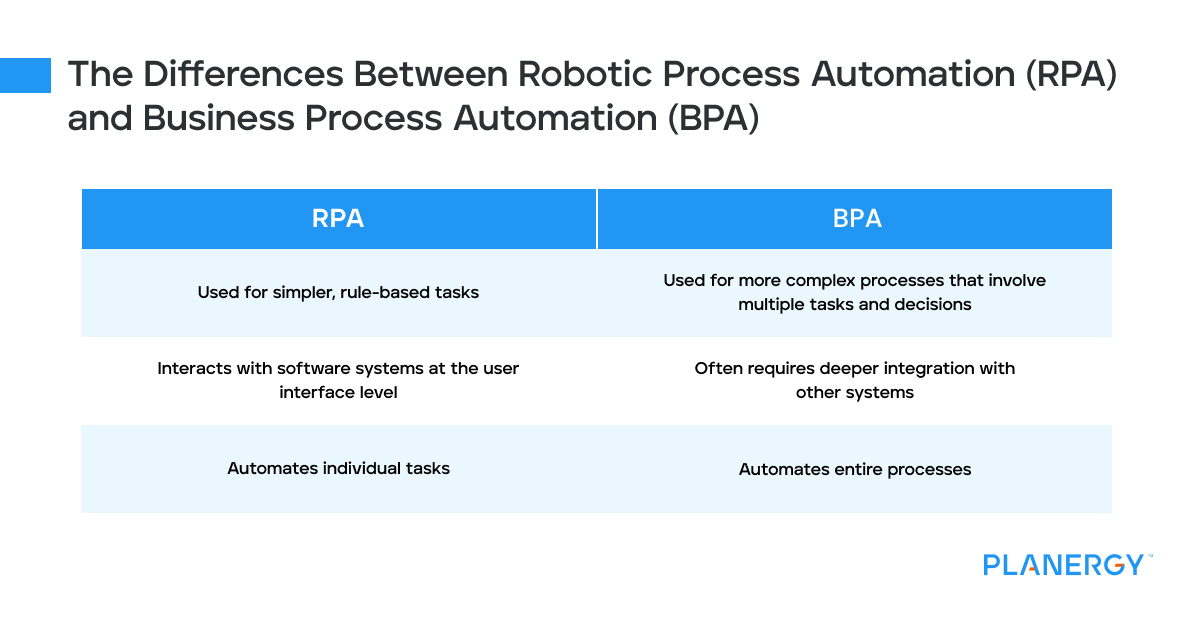
Level of Complexity: RPA is used for simpler, rule-based tasks, while BPA is used for more complex processes that involve multiple tasks and decisions.
Integration: RPA interacts with software systems at the user interface level, making it non-intrusive and easy to implement. BPA, on the other hand, often requires deeper integration with other systems.
Scope: RPA automates individual tasks, while BPA automates entire processes.
RPA and BPA are complementary technologies. RPA can be a component of a larger BPA strategy, handling the simpler, repetitive tasks within a process.
At the same time, BPA can provide the framework and coordination needed to automate more complex processes.
By using both technologies together, businesses can achieve higher automation and efficiency.
While the benefits of implementing RPA are clear, there are also significant challenges in the implementation process.
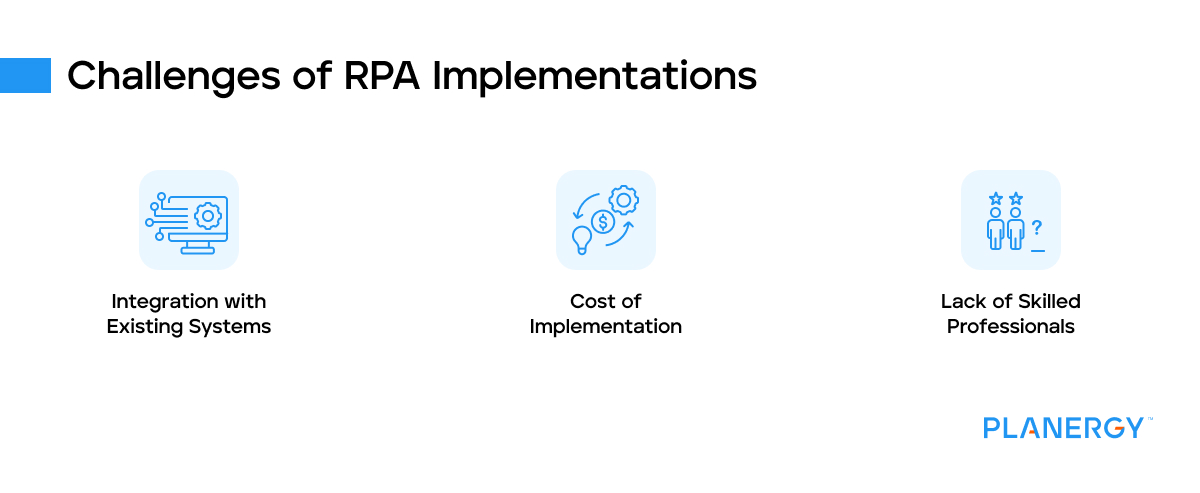
Integrating the new technology with existing systems is a significant challenge when implementing RPA and process automation.
This can be complex, especially if the current infrastructure is outdated or unsuitable for automation.
Though RPA itself works with various apps, understanding how to integrate it can be problematic for some.
This is especially true if you lack knowledge of all the available RPA tools.
Implementing RPA and process automation can be expensive, particularly for small and medium-sized businesses.
This includes the cost of the software itself, as well as training, system integration, and ongoing maintenance.
There’s a growing demand for professionals skilled in RPA and process automation, but the supply is limited.
This skills gap can make it difficult for businesses to find the expertise they need to implement and manage their automation projects.
To navigate the challenges and ensure you see the benefits of robotic process automation you should follow these best practices.
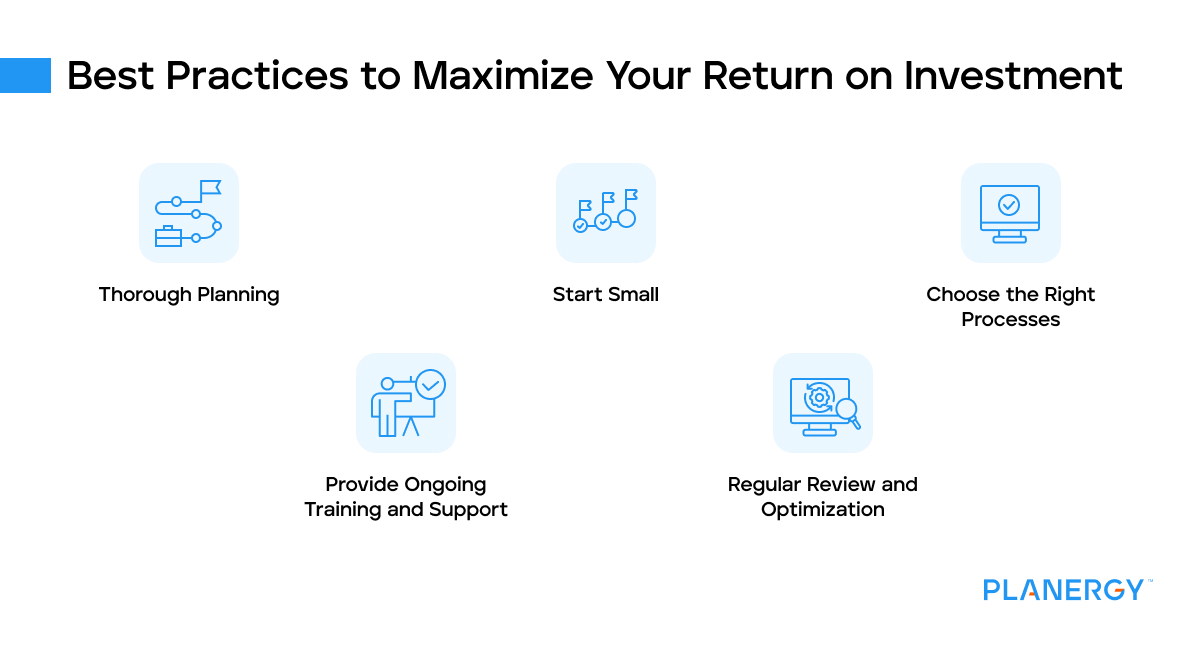
Before implementing RPA or process automation, it’s essential to have a clear plan in place.
This should include a detailed understanding of the processes to be automated, the goals of the project, and the metrics by which success will be measured.
Begin with a pilot project, learn from it, and gradually scale up.
This allows you to test the technology, identify potential, and make adjustments before launching at full scale.
Not all processes are suitable for RPA. Choose those that are rule-based, repetitive, and have a high volume.
Training is a crucial part of any automation project. Employees must understand how to work with the new technology and how it will impact their roles.
Providing ongoing support can help ensure that the transition to automation goes smoothly.
Intelligent automation isn’t a set-it-and-forget-it solution. It’s important to regularly review your automated processes’ performance and make necessary adjustments.
This can help you maximize the benefits of automation and ensure that it continues to meet your business needs.
By understanding these challenges and following these best practices, businesses can successfully implement RPA and process automation and reap the benefits of increased efficiency and productivity.
The future of RPA looks promising with the emergence of hyperautomation, a concept that combines RPA, AI, machine learning, and other advanced technologies.
This allows for more complex processes to be automated, pushing the boundaries of what can be achieved with automation.
In conclusion, RPA is an exciting technology that, when implemented correctly, can drive significant business benefits.
As we move into the future, combining RPA solutions with other advanced technologies will continue transforming businesses in ways we can only imagine.
We’ve helped save billions of dollars for our clients through better spend management, process automation in purchasing and finance, and reducing financial risks. To discover how we can help grow your business:
Browse hundreds of articles, containing an amazing number of useful tools, techniques, and best practices. Many readers tell us they would have paid consultants for the advice in these articles.
We use cookies to personalise content and ads, to provide social media features and to analyse our traffic. We also share information about your use of our site with our social media, advertising and analytics partners who may combine it with other information that you’ve provided to them or that they’ve collected from your use of their services.
Read our privacy statement here.
Stay up-to-date with news sent straight to your inbox
Sign up with your email to receive updates from our blog